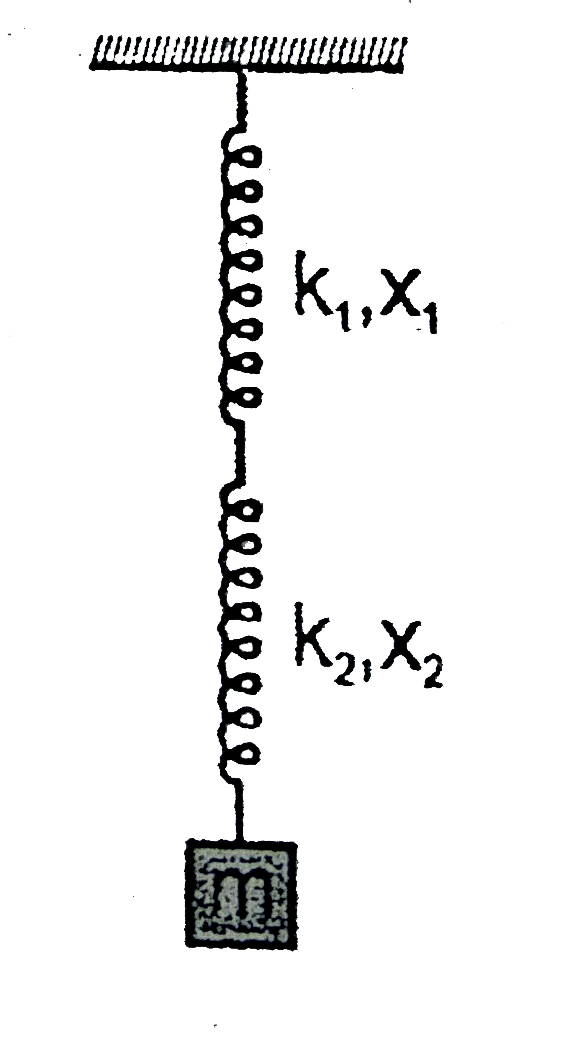A graph paper is situated on a board as shown in figure. Near the graph paper a spring is placed. A pencil attached to the end of the spring as shown in figure. The pencil is free to move on the graph paper. A stone of mass 50g m is placed 1 m above the spring. [Spring constant ]. What will happen to the length of mark if spring having smaller spring constant is used? Justify.![A graph paper is situated on a board as shown in figure. Near the graph paper a spring is placed. A pencil attached to the end of the spring as shown in figure. The pencil is free to move on the graph paper. A stone of mass 50g m is placed 1 m above the spring. [Spring constant k= 98N/m]. What will happen to the length of mark if spring having smaller spring constant is used? Justify.](https://d10lpgp6xz60nq.cloudfront.net/physics_images/EXP_SPS_PHY_XI_C06_E06_024_Q01.png) Solution in Malayalam
Solution in Malayalam
Step by step video & image solution for A graph paper is situated on a board as shown in figure. Near the graph paper a spring is placed. A pencil attached to the end of the spring as shown in figure. The pencil is free to move on the graph paper. A stone of mass 50g m is placed 1 m above the spring. [Spring constant k= 98N/m]. What will happen to the length of mark if spring having smaller spring constant is used? Justify. by Physics experts to help you in doubts & scoring excellent marks in Class 11 exams.
Updated on:21/07/2023Topper's Solved these Questions
Similar Questions
Find the odd one out and find the relation connecting the remaining quantities. Joule, Calorie,Kilowatt, electron volt
View SolutionVelocity of sound in vaccume is
View SolutionA particle of mass m is moving with a constant speed v in a circular path in a smooth horizontal plate (plan of the paper ) by a spring force as shown in figure If the natural length of the spring is l_(0) and stiffeness of the spring is k find the elongation of the spring
View Solutionspring of force constant k clamped rigidly at onoe end and a mass m attached to its free end. A force F applied at the free end stretches the spring. Figure shows the same spring with both ends free and attached to a mass m at either end. Each end of the spring in figure is stretched by the same force F.
(a) What is the maximum extension of the spring in the two cases ?
(b) If the mass in figure and the two masses in figure are released free, what is the period of oscillation in each case?

View SolutionTwo springs are in a series combination and are attached to a block of mass 'm' which is in equilibrium. The spring constants and extension in the springs are as shown in the figure. Then the force exerted by the spring on the block is :

View SolutionTwo masses m and 2m are attached to two ends of an ideal spring as shown in figure. When thye spring is in the compressed state, the energy of the spring is 60 J, if the spring is released, then at its natural length
View SolutionA block of mass m is placed on a smooth block of mass M = m with the help of a spring as shown in the figure. A velocity v_(0) is given to upper block when spring is in natural length. Find maximum compression in the spring.
View Solutionकिसी स्प्रिंग तुला का संकेतक पाठ्यांक व लोड ग्राफ , चित्र में दर्शाया गया है। स्प्रिंग नियतांक है

View SolutionFigure a) shows a spring of force constant k clamped rigidly at once end and a mass m attached to its free end. A force F applied at the free end stretches the spring. Figure b) shows the same spring with both ends free and attached to a mass m at either end. Each end of the spring in figure is stretched by the same force F.
(a) What is the maximum extension of the spring in the two cases ?
(b) If the mass in figure and the two masses in figure are released free, what is the period of oscillation in each case?

View SolutionFigure 14.26 (a) shows a spring of force constant k clamped rigidly at one end and a mass m attached to its free end. A force F applied at the free end stretches the spring. Figure 14.26 (b) shows the same spring with both ends free and attached to a mass m at either end. Each end of the spring in Fig. 14.26(b) is stretched by the same force F.

What is the maximum extension of the spring in the two cases ?
View SolutionTwo springs are connected to a block of mass M is placed on a frictionless surface as shown in figure. If both springs have a spring constant k, the frequency of oscillation of the block is………

View SolutionA particle of mass m is attached to three identical massless springs of spring constant k as shown in the m 135 figure. The time period of vertical oscillation of the particle is

View SolutionA graph paper is situated on a board. Near the graph paper a spring is placed. A pencil is attached to the end of the spring. The pencil is free to move on the graph paper. A stone of mass 50g m is placed 1 m above the spring. [Spring constant k=98Nm] . the energy possessed by the stone due to its height is called ⋯.
View SolutionA particle of mass m is moving with a constant speed v in a circular path in a smooth horizontal plate (plan of the paper ) by a spring force as shown in figure If the natural length of the spring is l0 and stiffeness of the spring is k find the elongation of the spring

View SolutionTwo springs are in a series combination and are attached to a block of mass 'm' which is in equilibrium. The spring constants and extension in the springs are as shown in the figure. Then the force exerted by the spring on the block is :
View Solution
